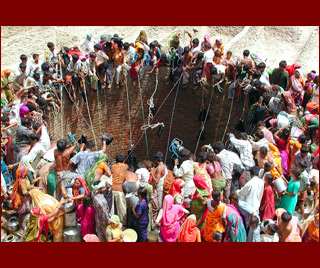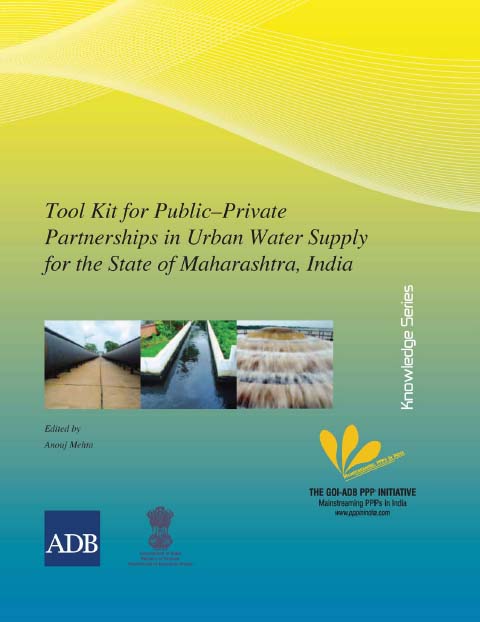/topics/rural-water
Rural Water
Draft guidelines for taking up works relating to access to sanitation facilities by Ministry of Rural Development - Request for comments by August 15, 2011
Posted on 09 Aug, 2011 11:15 PMThe Ministry of Rural Development, Government of India has developed draft guidelines expanding the scope of works under schedule 1 Para 1 (ix) of Mahatma Gandhi National Rural Employment Guarantee Scheme to include access to sanitation facilities. This has been prompted by demands from several States/quarters for ensuring sanitation facilities in rural areas with the main goal of ensuring a clean environment, thereby bringing about an improvement in the general quality of life and strengthening the livelihood base.
Rural drinking water supply and sanitation - Standard operating procedure for responding to natural disasters - Department of Drinking Water and Sanitation
Posted on 05 Aug, 2011 08:37 PMThis standard operating procedure developed by the Department of Drinking Water and Sanitation includes all functions pertaining to disaster prevention, institutional mechanism, preparedness, early warning, relief, recovery and rehabilitation. It will apply to RWSS Department/ PHED/ PRED/ Sanitation Departments/ Board dealing with rural water supply and sanitation for natural disasters that the State is prone to. The standard operating procedure will not be applicable to nuclear, biological and chemical disasters.
Managing drinking water security - A handbook for Gram Panchayats by the Department of Drinking Water Supply (MoRD)
Posted on 27 Jul, 2011 10:03 PM This handbook for Gram Panchayats has been prepared by the Water and Sanitation Program (World Bank) for the Department of Drinking Water Supply, Ministry of Rural Development, Government of India.
This handbook for Gram Panchayats has been prepared by the Water and Sanitation Program (World Bank) for the Department of Drinking Water Supply, Ministry of Rural Development, Government of India.
The Department of Drinking Water Supply (DDWS) launched the National Rural Drinking Water Program (NRDWP) in April, 2009. The NRDWP builds on experiences gained through past efforts by many stakeholders and brings all existing rural drinking water initiatives under a single program. The focus of the NRDWP is to ensure drinking water security for all rural citizens in India. Drinking water security means providing every rural person with enough safe water for drinking, cooking and other domestic needs at all times and in all situations, including periods of drought and flood and for livestock.
A kalyani brought to life in Mulbagal, Karnataka: An Arghyam initiative
Posted on 27 Jul, 2011 05:58 PMGuest post by Manjunath Prasad
The political economy of sanitation - How can we increase investment and improve service for the poor? – A report by Water and Sanitation Program
Posted on 26 Jul, 2011 02:53 PM This global study attempts systematically to understand and thus help practitioners manage the political economy of pro-poor sanitation investments and service provision.
This global study attempts systematically to understand and thus help practitioners manage the political economy of pro-poor sanitation investments and service provision.
It aims to provide practical advice to multi-lateral agencies and sanitation practitioners to help them better manage stakeholder relations and effectively maneuver within the complex institutional relationships of the sanitation sector in order to enhance the design, implementation, and effectiveness of operations that provide pro-poor sanitation investments and services. The ultimate goal is to improve health and hygiene outcomes.
This study follows current approaches to political economy - interdisciplinary inquiry drawing upon social and political theory and economic principles - to understand how political actors, institutions, and economic processes influence each other. This study’s conceptual framework combines a diagnostic component with a typology of actions to help translate analytical findings into more effective support to operations and investments.
India must prepare for future growth by planning a low-water economy - Article in YaleGlobal Online by Rohini Nilekani
Posted on 19 Jul, 2011 12:37 PMArticle and Image courtesy: YaleGlobal Online
Author: Rohini Nilekani
India and China account for one third of the world’s population; each consumes more freshwater than other nations. Per inhabitant per year, though, India uses less than half what’s used in the US, China uses less than one third. This YaleGlobal series examines India and China’s water use, their expectations for rising demand and recognition that shortages will disrupt economic progress.
The Planning Commission of India repeatedly warns that water will become a more serious issue than land or energy for India in years to come, points out Rohini Nilekani, in the second article of the series. India’s transition from an economy based on agriculture to a mixed one, with water use controlled by states rather than the federal constitution, already leads to conflicts. She urges planning for a low-water economy. Good governance and regulatory frameworks can prevent pollution and waste, while encouraging efficiency, reliable and fair allocation, and wise consumer choices.
 Thirsty earth: Indian villagers in Gujarat gather to draw water from a well
Thirsty earth: Indian villagers in Gujarat gather to draw water from a well
Geomorphic study for regeneration of aquatic ecosystem in Bareilly – An article in Geospatial World
Posted on 17 Jul, 2011 10:53 AMIt indicates that the aquatic ecosystem of an area disappeared due to unplanned development of agro ecosystems and human settlements. This area was earlier covered with ponds, wetlands and ox-bow lakes. Now, during the rainy season, inhabitants of these wards face severe problem of water logging and pollution.
Public-Private Partnerships in urban water supply for Maharashtra – Tool kit by GoI-ADB PPP Initiative
Posted on 16 Jul, 2011 06:48 PM
The various possible PPP structures for the sector were studied, and their applicability assessed in the context of the selected sample cities. Consultations led to development of term sheets for these PPP structures, which were identified as most suitable and feasible for implementation.
The above exercise has led to development of this report, which may be considered as a tool kit designed to help decision makers decide whether a particular project might be suitable for the PPP route or not. The tool kit can, therefore, be the basis for approving a project implementation structure as part of the overall project approval methodology.
Groundwater - Nation’s water lifeline suffering multiple crisis – A presentation by Himanshu Thakker
Posted on 13 Jul, 2011 09:41 PM
This has been followed with a discussion on issues of quality and quantity. The importance of groundwater in India’s water sector is highlighted. The presentation discusses how an increase in overall irrigated area, in spite of decrease in contribution from big dam irrigation projects was possible due to the steep increase in groundwater irrigated areas.
The Department of Land Resources under the Ministry of Rural Development in consultations with the National Rainfed Area Authority issue revised guidelines on the inclusion of forest areas under the Integrated Wasteland Management Program - PIB release
Posted on 12 Jul, 2011 10:41 AMArticle courtesy: Press Information Bureau
As per the modifications in Para IX of the common guidelines for Watershed Development Projects, 2008, in the multi tier approach, it has been proposed that there would be a multi tier ridge to valley sequenced approach which should be adopted towards the implementation of the Watershed Development Projects.





